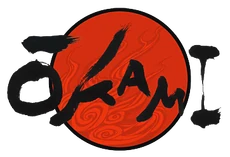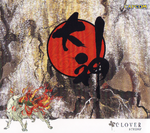mNo edit summary Tag: sourceedit |
m (→Story) Tag: sourceedit |
||
| Line 3: | Line 3: | ||
[[File:Ōkami - Now Gorgeously Painted in High Definition!|thumb|right|335 px]] |
[[File:Ōkami - Now Gorgeously Painted in High Definition!|thumb|right|335 px]] |
||
== Story == |
== Story == |
||
| − | Set in an unspecified period of classical Japanese history, ''Ōkami'' combines several Japanese myths, legends and folklore to tell the story of how the land was saved from darkness by the Shinto sun goddess Amaterasu, who has taken the form of a white wolf. It features a distinct ''sumi-e''-inspired cel-shaded visual style and the Celestial Brush, a gesture-system to perform miracles. |
+ | Set in an unspecified period of classical Japanese history, ''Ōkami'' combines several Japanese myths, legends and folklore to tell the story of how the land was saved from darkness by the Shinto sun goddess [[Amaterasu]], who has taken the form of a white wolf. It features a distinct ''sumi-e''-inspired cel-shaded visual style and the Celestial Brush, a gesture-system to perform miracles. |
== Characters == |
== Characters == |
||
Revision as of 19:18, 6 January 2017
Ōkami (「大神」or「狼」, Great god or Wolf in Japanese, respectively) is an action-adventure video game developed by Clover Studio and distributed by Capcom. It was originally released for the PlayStation 2 in 2006 in Japan and North America, and 2007 in Europe and Australia. Despite the closure of Clover Studio a few months after the PS2 release, a port for Nintendo's Wii console was produced by Ready at Dawn and Capcom, which was released in North America on April 15, 2008, and in Europe in June 2008. A high-definition port of the game was released on the PlayStation 3 via the PlayStation Network in October 2012 and for retail in Japan in November 2012, supporting the use of the PlayStation Move motion controller. The game is now known as one of Capcom's finest achievements, and is the first game in the Ōkami series.

Ōkami - Now Gorgeously Painted in High Definition!
Story
Set in an unspecified period of classical Japanese history, Ōkami combines several Japanese myths, legends and folklore to tell the story of how the land was saved from darkness by the Shinto sun goddess Amaterasu, who has taken the form of a white wolf. It features a distinct sumi-e-inspired cel-shaded visual style and the Celestial Brush, a gesture-system to perform miracles.
Characters

Amaterasu and the thirteen Celestial Brush gods.
- Amaterasu
- Issun
- Sakuya
- Susano
- Kokari
- Kushi
- Mr. and Mrs. Orange
- Waka
- Spider Queen
- Crimson Helm
- Blight
- Orochi
- Yami
Common enemies
- Green Imp
- Red Imp
- Yellow Imp
- Blue Imp
- Black Imp
- Headless Guardian
- Bell Guardian
- Halo Guardian
- Executioner Guardian
- Namahage
- Blade Namahage
- Bucket Namahage
- Umbrella Namahage
- Cannon Namahage
Gameplay
Ōkami has the player controlling the main character, Amaterasu, in a woodcut, watercolor style, cel-shaded environment, which looks like an animated Japanese ink-illustration (known as sumi-e) with other styles of art. The gameplay style is a mix of action, platform, and puzzle gaming genres, and has been noted by many reviewers to have numerous similarities in overall gameplay style to The Legend of Zelda series, an inspiration that director Hideki Kamiya, a self-proclaimed Zelda-fan, has admitted has influenced his general game design.[1] The main story is primarily linear, directed through by Amaterasu's guide Issun, though numerous side quests and optional activities allow for players to explore the game world and take the story at their own pace. By completing quests, side quests and small additional activities (such as making trees bloom into life or feeding wild animals), Amaterasu earns Praise, which can then be spent to increase various statistics of the character, such as the amount of health and number of ink wells for Celestial Brush techniques.
Combat is staged in a ghostly virtual arena, and Amaterasu can fight enemies using a combination of weapons, fighting techniques and Brush methods to dispatch the foes. At the end of combat, money (as yen) is rewarded to Amaterasu, with bonuses for completing a battle quickly and without taking damage. The money can be spent on numerous items from merchants across the land, including healing goods, better weapons, tools and key items for completing quests. The money can also be used to buy new combat techniques at dojos throughout the land. Additionally, rare Demon Fangs can be earned through combat which can be traded for additional, unique items that are beneficial in gameplay but not required to complete the game.
Weapons inspired by the Imperial Regalia of Japan, the Reflector, the Rosaries and the Glaive can be equipped on Amaterasu as either a main or sub-weapon, and used in addition to other melee attacks that the player can have Amaterasu learn through the course of the game.
Celestial Brush
Unique to Ōkami is the Celestial Brush. Players can bring the game to a pause and call up a canvas, where the player can draw onto the screen, either using the left analog stick on the PlayStation 2's DualShock controller or pointing with the Wii Remote. This feature is used in combat, puzzles and as general gameplay. For example, the player can create strong wind by drawing a loop, cut enemies by drawing a line through them or create bridges by painting one, amongst many other abilities. These techniques are learned through the course of the game by completing constellations to release the Celestial Brush gods (inspired by the East Asia zodiac) from their hiding spots. It is also possible to upgrade or modify certain Brush powers later in the game. For example, the Celestial Brush power Inferno can gain a new power called Fireburst, which has a different drawing pattern, and allows players to create flames without relying on torches or other related items. The player's ink for drawing is limited by the amount available in special ink wells (unless an Inkfinity Stone is used), preventing the player from solely using Brush techniques to defeat enemies. Ink Pot is restored in the wells over time when the Brush is not used.
Development
Ōkami resulted from the combined ideas of Clover Studio. The game was originally built around "depict[ing] a lot of nature", but had no central concept or theme, according to lead designer Hideki Kamiya.[2] Kamiya eventually created a minute-long demonstration movie showing a wolf running about a forest, with flowers blossoming in its wake, but still lacked any gameplay. Kamiya and other members of the team introduced ideas around the nature aspect and eventually led to the game's initial prototype, which Kamiya admitted was "incredibly boring to play". Kamiya suggested that he allowed so many ideas from the team that resulted in the development moving off-target, including creating more of a simulation. Eventually, they settled onto the gameplay found in the final product.
The art in Ōkami is highly inspired by Japanese watercolor and wood carving art of the Ukiyo-e style, such as the work of Hokusai. Ōkami was originally planned to be rendered in a more photorealistic 3D style.[3] However, Clover Studio determined that the more colorful sumi-e style allowed them to better convey Amaterasu's association with nature and the task of restoring it.[4] The change was also influenced by limitations in the PS2 hardware to render the photorealistic 3D graphics.[5] As a result of the switch to the watercolor style, the idea of the Celestial Brush came about.[6] Atsushi Inaba, CEO of Clover, noted that "Once we fixed ourselves on a graphical style and got down to the brushwork, we thought 'Wouldn't it be great if we could somehow get the player involved and participate in this artwork instead of just watching it?' That's how the idea of the Celestial Brush was born". Original concepts for enemies included the use of dinosaurs, but the designs settled onto more demon-like characters.
Amaterasu's initial designs were aimed to avoid having the character look like "your pet wearing clothing". The developers had considered having Amaterasu change into a dolphin when in the water and a falcon when jumping off a cliff, but dropped these ideas. Sakuya, designed around a peach motif, was envisioned with what were called "level 2" and "level 3" designs where the character would wear less clothing as the story progressed, but the "level 3" appearance, effectively naked, was vetoed by Inaba. Waka's character was aimed to be a Tatsunoko-like character, with the hood designed to be reminiscent of those worn by the Gatchaman. Orochi in Japanese mythology is a gigantic creature, so lead character designer Takeyasu Sawaki designed the back of the demon to include a garden and palace; this inspired the game designers to include a bell in those structures that would be Orochi's fatal weakness in the game.
The localization team had to translate 1500 pages of text to make sure it made sense in a "native check", due to lack of plurals in the Japanese language and the large number of characters and conditional conversations that the player could interact with. The team recognized that certain elements of the game would not be recognized by Western audiences, but left enough text and details to allow the players to look up the information for themselves. Only one puzzle in the game had to be changed as it required knowledge of the steps in drawing a kanji character which would be readily known for Japanese audiences; for the Western release, these steps were demonstrated in the game. The team noted that personalities of characters could be easily conveyed in Japanese text simply by the way sentences were constructed or slurred, a feature that could not directly be applied to localization. Instead, working with Kamiya, the team scripted the localization to either recreate the personality to match the Japanese version, or to create a whole new set of mannerisms for the characters as appropriate.
Ōkami was shown at the 2005 E3 Convention, approximately 30% complete, with a planned release in 2006.[7] At this point, the game had much of the core gameplay, including the Celestial Brush and the combat system in place. The game was released a year later in 2006. However, just a few weeks following its release in North America to strong critical reception, Capcom announced the closure of Clover Studio.[8]
The Ōkami: Official Complete Works art book was published by Udon in May 2008.[9]
Reception and Legacy

Screenshot from the HD version
Ōkami was one of the last few PS2 games selected for release prior to the release of the PlayStation 3. Although it suffered from poor sales, Ōkami earned high acclaim from reviewers and earned awards. The game was re-released under Sony's "Greatest Hits" in Japan in August 2008.[10]
The Wii version has received similar praise, though the motion control scheme has gotten mixed reviews from both critics and gamers.
A high-definition port of the game was released on the PlayStation 3 via the PlayStation Network in October 2012 and for retail in Japan on 1 November 2012, supporting the use of the PlayStation Move motion controller.

Ōkami in the mother's hand.
A sequel entitled Ōkamiden was released for the Nintendo DS.
At the E3 2016 during an interview with Metro, Kamiya, now at Platinum Games, stated that he had ideas for a Ōkami 2, though did not confirm if the game was in active development.[11]
Trivia
- In episode 161 of American animated dark comedy show South Park, Ōkami was referenced as the cover art for the game was visible in certain parts of the episode.
Gallery
Box Art
Merchandise
References
- ↑ http://www.1up.com/do/feature?cId=3152880
- ↑ http://www.1up.com/do/newsStory?cId=3176767
- ↑ http://www.gamevideos.com/video/id/5057
- ↑ http://www.1up.com/do/feature?cId=3152846
- ↑ http://ps2.ign.com/articles/759/759997p1.html
- ↑ http://ps2.gamespy.com/playstation-2/okami/690940p1.html
- ↑ http://www.gamespot.com/ps2/adventure/okami/preview_6125972.html
- ↑ http://www.gamespot.com/news/6159721.html
- ↑ http://www.udonentertainment.com/okami/
- ↑ http://www.siliconera.com/2008/08/07/okami-odin-sphere-and-disgaea-joining-ps2-greatest-hits/
- ↑ http://metro.co.uk/2016/06/17/hideki-kamiya-hints-at-okami-2-and-bayonetta-3-5950079/















